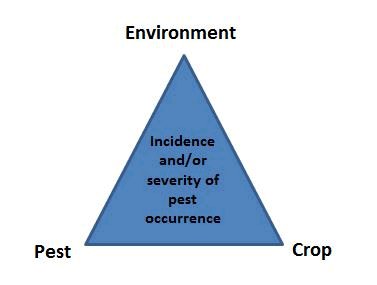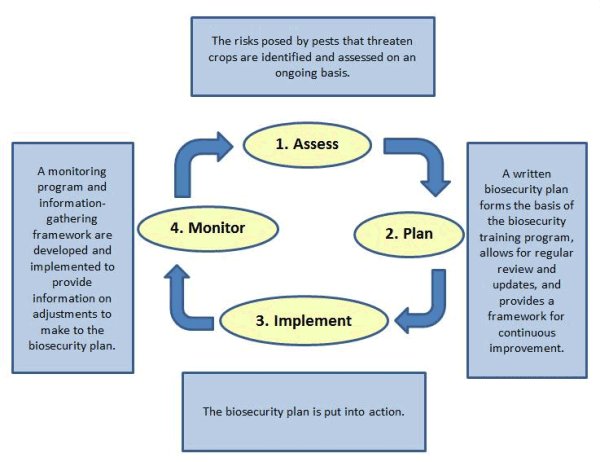Floriculture Sector Biosecurity Guide
1.0 Introduction
1.1 The Importance of Biosecurity
Biosecurity is a set of practices used to prevent, minimize and manage the transmission of pests, including their introduction, spread and release. Implementing and enhancing biosecurity practices within a facility helps protect individual and sector-wide economic interests. Producers can benefit from increasing their awareness of biosecurity risks and of the measures that can be implemented at their facilities to minimize the risk of pest introduction and spread.
Due to the intensive nature of production, limited genetic diversity within crops and frequency of facility-to-facility movement, threats to the biosecurity of a facility may develop rapidly and spread to other facilities with surprising ease. Implementing sound biosecurity practices within a facility can help mitigate many pest risks through reduced incidences of pest introduction, more effective management of pest problems and prevention of pest spread to other facilities.
1.2 Biosecurity Concepts
Implementing biosecurity measures can be effective not only for mitigating the spread of pests but also for preventing the introduction of new and unknown pest risks. Applying biosecurity measures depends on an analysis of the risks and pathways of pest transmission for a facility. Knowledge of pests and their pathways of transmission is important when developing a biosecurity plan. With this knowledge, pest vectors can be managed and biosecurity measures can be applied to interrupt pest pathways of transmission, reducing crop damage and minimizing economic losses. Examples of pathways of pest transmission can include insects, employees, equipment and wind.
To determine the critical points in pest pathways of transmission where biosecurity measures may be applied, a risk assessment may be conducted. The risks to a facility will vary depending on several factors such as the type of crop grown, source(s) of propagative material, region, climate and production practices.
As illustrated in Figure 1, pest outbreaks do not happen in isolation but are dependent on the interrelated nature of the crop, the environment and the pest.
- Crops: Without a susceptible crop, there is a lower risk of pest infestation.
- Pests: Keep pests from entering the production area.
- Environment: Certain environmental conditions can be more or less favorable to the development of pests.
Pest risks may be mitigated by applying biosecurity measures to manage the interaction of these three components. For example, a producer may choose to grow pest-tolerant plant varieties or manage the environment, such as by increasing plant spacing to reduce humidity, which helps prevent the development of pests.
Figure 1: The Plant Pest Triangle

Description for photo - The Plant Pest Triangle
The image shows a triangle with the words "Incidence and/or severity of pest occurrence" written in it. By the top corner is the word "Environment". By the bottom right corner is the word "Crop". By the bottom left corner is the word "Pest".
1.3 Benefits of a Biosecurity Plan: What's In It For Me?
A benefit of a biosecurity plan is that it allows producers to take a preventative approach rather than managing the introduction or spread of pests. If a pest is detected, there are protocols already in place to facilitate a rapid response, thereby minimizing the damage from pests or their further spread and breaking the cycle of pest transmission between facilities. Other benefits of incorporating biosecurity measures into the day-to-day activities of a facility include the following:
- Manages the risk of business interruption as a result of harmful pest detections at a facility.
- Meets customer and consumer demand for pest-free and healthy plants.
- May assist in attracting new markets.
- Decreases production losses.
1.4 Elements of a Biosecurity Plan
Biosecurity plans will differ from one facility to another, as biosecurity measures and requirements will vary depending on the facility. A biosecurity plan may include a detailed facility map(s); training programs; and Standard Operating Procedures for elements such as pest monitoring and response as well as the movement of people, equipment and vehicles. Documenting these procedures can ensure consistent application and demonstrate to customers that a facility operates using biosecurity measures.
Other phytosanitary certification programs (e.g. Canada Greenhouse Certification Program, Japanese beetle program) may already be used within a facility and include elements that apply to biosecurity. These programs can be referenced as part of a biosecurity plan.
To develop a biosecurity plan, consider the following process:
Step 1: Develop a detailed map of the facility. A map can be useful for visualizing and identifying potential sources of pests or pathways of pest transmission. A map may include the entrance, shipping area, receiving area and high-risk areas. The flow of plant material, people and equipment within the facility can also be included.
Step 2: Identify the risks to the facility. Knowledge of pests and their pathways of transmission can help to identify pest risks as well as the biosecurity measures that can help mitigate these risks.
Step 3: Review current biosecurity measures. The self-assessment checklists and the Floriculture Sector Biosecurity Guide Self-Assessment Checklist and Action Work Plan can be used to help identify additional biosecurity measures that could be implemented at a facility.
Step 4: Identify biosecurity goals. Prioritize and establish a timeline for implementing the additional biosecurity measures identified after completing the self-assessment checklists or the Floriculture Sector Biosecurity Guide Self-Assessment Checklist and Action Work Plan.
Step 5: Develop an implementation strategy. Communication of the biosecurity practices and education and training of employees and visitors regarding biosecurity measures are an important part of the implementation strategy.
Step 6: Review and update the biosecurity plan. A biosecurity plan should be regularly reviewed and updated as new biosecurity information becomes available or if there are changes within a facility.
1.5 Implementing a Biosecurity Plan
As represented by Figure 2, the implementation of biosecurity measures in a facility forms a cycle of biosecurity activities. Assessment and re-assessment can be seen as both the starting and end points of the cycle, leading to a proactive approach.
Figure 2: Cycle of biosecurity activities

Description for photo - Cycle of biosecurity activities
Figure 2 is an illustration of the cycle of activities that should be completed to develop and implement a Biosecurity Plan. The cycle of biosecurity has four items with arrows pointing between them in a clockwise direction. The first item at the top of the cycle is "Assess". Moving clockwise, the second item is "Plan", the third is "Implement" and the fourth is "Monitor". There is a text box by each of these four items in the cycle. The text box by the word "Assess" states: "The risks posed by pests that threaten plants are identified and assessed on an ongoing basis." The text box by the word "Plan" states: "A written Plan forms the basis of the biosecurity training program, allows for regular review and updates, and provides a framework for preparedness." The text box by the word "Implement" states: "The Plan is put into action." The text box by the word "Monitor" states: "A monitoring program and information-gathering framework are developed and implemented to provide information on adjustments to make to the Plan."
Assess: Identify and assess pest introduction risks and analyze probable transmission pathways. This allows producers to address current biosecurity gaps within a facility. Production practices should be reviewed frequently (reassessed) to ensure that implemented measures are effective.
Plan: A written biosecurity plan is highly recommended. A written biosecurity plan allows for regular review and updates, supports continuous improvement within the facility and forms the basis for training.
Implement: Put the biosecurity plan into action. Education, training and communication are key to implementing the biosecurity plan.
Monitor: Develop and implement an information-gathering system that provides information to adjust the biosecurity plan. It is important to assess the design, effectiveness and implementation of the biosecurity plan routinely but also when there are changes in facility practices or when a biosecurity risk occurs.
- Date modified: